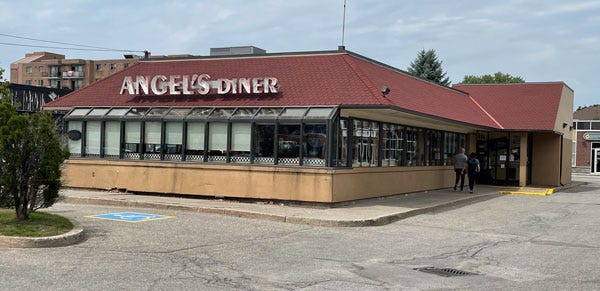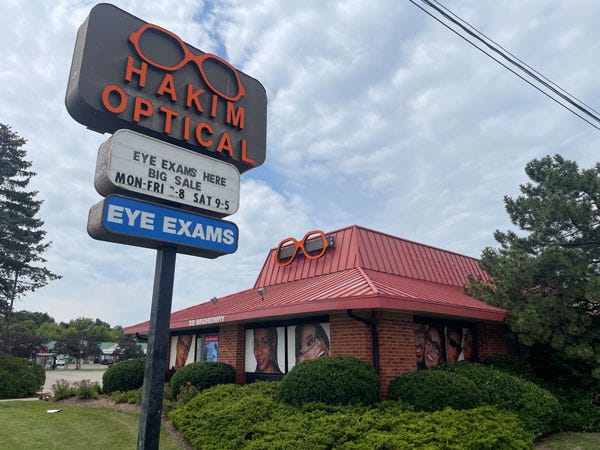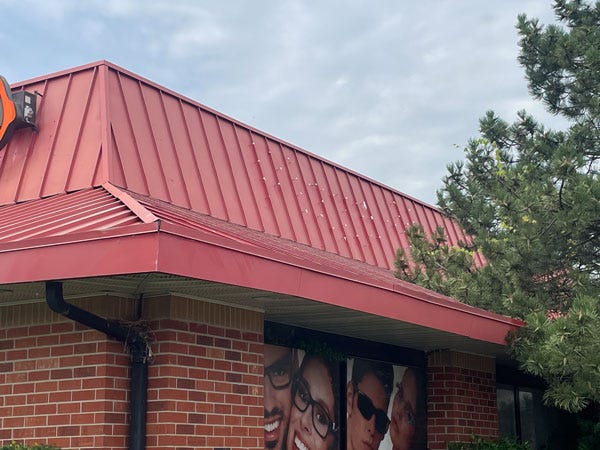Welcome to Willoughby Hills!
If you enjoy what you’re reading, please consider a free subscribtion to receive emails every Wednesday and Sunday plus podcast episodes every two weeks. There are also paid options, which unlock even more features.
As is typical every Wednesday, I’m bring you a smattering of topics that I hope will make you a bit more curious about the world around you and give you something to think about later. I call these Wednesday Walks, as it’s the type of conversation we might have walking down a path in the woods. Shall we take a stroll?
Read the Sign
Ever since Elon Musk officially rebranded Twitter to X a few weeks ago, I’ve read several articles analyzing the move as foolish. Many commentators have argued that Twitter was an iconic brand that was well recognized throughout the world and X still very much an unknown. Brand awareness is a major part of marketing, and Twitter, the term tweeting, and the blue bird logo were all very well known.
The discourse around this rebranding had be thinking about what it is that makes a successful brand in the eyes of the public. What does it take to reach iconic status?
I found the answer rather unexpectedly on a commercial strip in Orangeville, Ontario, a rural exurb about an hour outside of Toronto where I stayed over the weekend. I was sitting at a red light looking at the signage around me (as one does, right?) when I saw a sign that I both knew and didn’t know.
Even though I was in a foreign country, the sign felt instantly familiar to me: the shape, the height off of the ground. The only thing that was wrong with it was it had the wrong business name on it. Take a look and see if you know what I mean.
If you’re not as well versed in roadside signage and Americana, this one might not stand out to you as much, but to me, all I could think was “Angel’s Diner clearly used to be a Burger King.”
That’s the power of a brand- when it can speak to you long after it’s left a location. When the mere shape of its sign can fill in the brand name and logo for you. When the curved square sign instantly conjures up the smell of fried onion rings, even though it’s been almost 30 years since anyone “had it your way” at this location (this diner has been in this space since 1996).
And was I right in my assumption that this was an old Burger King? Well, here’s what the restaurant building looks like. What do you think?
And here’s an example of a typical Burger King, this particular one from 1989.

Without logos or the Burger King color scheme, the restaurant is still recognizable. It’s been easily a decade (probably longer) since I’ve eaten a Whopper, but the sign profile, architecture, and other characteristics that aren’t directly related to the logo still stand out to me. That’s the power of a strong brand.
Next door to this former Burger King is another former restaurant that has been adapted for a new use. This one should be even easier to identify.
The orange glasses do nothing to mask the red roof and brick walls that were clearly once a Pizza Hut. In fact, the mounting hardware for the Pizza Hut sign is still visible on the roof if you look closely.
To an American like me, this building screams Pizza Hut, but to Canadians, Hakim Optical is perhaps just as iconic. The chain was founded by Karim Hakimi, an immigrant from Iran, in 1967. Today, the business operates more than 160 showrooms and 120 one-hour factory outlet stores across Canada.
Oddly enough, both Burger King and Pizza Hut still operate in Orangeville, just not at their original locations. Pizza Hut abandoned their large format, dine-in model for a smaller store front in a strip mall less than 2 miles away which only offers carryout and delivery. And Burger King now operates as a small takeout stand located within a Petro-Canada gas station that’s next door to the new Pizza Hut.
Will X one day be as iconic as Burger King, Pizza Hut, and (apparently) Hakim Optical? If signage helps make a business iconic, the fact that X had to remove it’s non-permitted, obnoxiously lit sign from its San Francisco headquarters after only a few days doesn’t bode well for it’s staying power as a brand.
Speaking of Brands
While we were in Canada, my kids discovered a YouTube video from the channel Ryan’s World that also plays into the power of brands. In the video, Ryan, a child who rose to fame by (somewhat controversially) reviewing toys and his mother play a game where they see part of a logo and have to guess the company that it belongs to.
The video has 6.5 million views and is surprisingly fun to play along with. I enjoyed watching it with my kids this past weekend and since it ties into today’s theme, I figured I’d share it for anybody who needs a little diversion.
In a statement about the power of brands in the internet era, though, Ryan’s World is one of the most popular brands online that you may have never heard of (unless you have kids of a certain age). Preteen Ryan Kaji has been named the highest paid YouTube star for several years, making about $30 million in revenue in 2020. He has licensing deals with toy companies and apparel manufacturers. His likeness was turned into a float for the Macy’s parade. He is a sensation for kids of a certain age, but likely unknown to adults.
Whereas Burger King, Pizza Hut, McDonald’s, Disney, and Toys R Us were all once widely known and recognized brands, these days it seems that many companies are not as popular in the general public but are very well known within targeted groups. Our politics, our brand affiliations, and our media consumption has become much more specific, with huge names for one set of people meaning nothing to those outside the group.
Logging Off Zoom
I’ve talked a lot in this newsletter about return to office policies, remote work, and hybrid work arrangements. I have been a strong advocate for allowing flexibility in work that can promote work-life balance and reduce the time, cost, and emissions of commuting.
While I still believe that companies that offer the most flexibility will end up recruiting and retaining the best talent long term, I have been a bit surprised by how many companies (or at least executives) have embraced return to office policies.
The latest example of this is Zoom, the video conferencing company. According to reports, they are now requiring two days per week in person for any employee living within 50 miles of a Zoom office. The company helped make remote work possible and proved that location was irrelevant to connection, and now they are mimicking legacy corporation’s policies.
As the economy has seemed to head into a recession lately, I’ve been wondering if part of these return to office mandates are really just a way to thin out bloated workforces. Many employees prefer remote work or the option to work remotely, and companies that enforce in-person work requirements are likely counting on the policies causing some attrition.
Essentially, managers get the benefits of layoffs without the cost of things like severance packages. This dynamic was explained in a recent YouTube video from the channel The Golden Fox that came across my feed.
I once worked for a company that had its main office in a major metropolitan area. The business was sold to private investors that hoped to streamline operations, and part of this was a move out of the city office space and into a suburban office park. The move to this new office was heralded as a great victory by our new owners: not one job was going to be lost because of this move, even though private equity firms have a reputation for slashing workforces.
Of course, the new office location wasn’t convenient for everybody and over the next year or so, dozens of my co-workers ended up leaving and finding new jobs. In nearly all cases, their positions were not rehired. The private investors received a major reduction in staffing costs (and real estate costs) without having to pay out severance or deal with the headlines of mass layoffs.
I suspect something similar may be a foot here. In the case of Zoom in particular, Amanda Yeo at Mashable predicts that return to office is more about cost cutting than about enforcing attendance, utilizing real estate, or encouraging collaboration:
“Zoom's policy change probably has more than a few employees exploring their options, which may be a good idea even absent this new directive. Zoom laid off approximately 1,300 employees in February after its net profit plummeted from its pandemic-induced high, while founder and CEO Eric Yuan also took a temporary pay cut of 98 percent.
Millions of businesses switched to remote working due to the COVID-19 pandemic, with Zoom becoming the preferred video-conferencing platform for many. However, as numerous workplaces return to the office or adopt hybrid models, reliance on video calls has crashed and brought Zoom's revenue down with it.”
What’s most striking to me is that there is no single solution to return to office policies. For decades, the 5 day, 40 hour work week was a standard across many industries, but post-pandemic, it seems that companies are trying lots of different solutions before a new standard develops. Zoom is requiring 2 days per week, some other companies require 3 days, others one week per month. Some companies have shifted to a four day week, while others still use five.
What’s clear either way is that we are living through a major shift in the way that people and companies view jobs. It’s a long way from being fully settled, but changes are afoot. Remote work in some form is here to stay, at least until many of the white collar jobs that can benefit from that arrangement shift to AI jobs that require less staffing. It’s fascinating to observe, although unsettling to live through.
What do you think about remote working? Did you recognize the Burger King sign right away? Do you still use X or have you moved over to Bluesky, Threads, or something else? Or has the implosion of Twitter made you less plugged in overall? I’m curious to hear your thoughts.
I publish new issues every Wednesday and Sunday. Sign up to always receive the latest issue and support my work:
Other Wednesday Walks
If you’ve missed past issues of this newsletter, they are available to read here.








